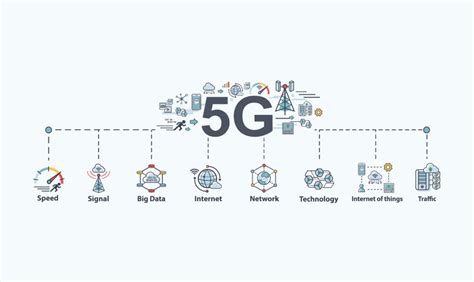How 5G is Revolutionizing the Tech Industry

Discover how 5G is revolutionizing the tech industry, transforming everything from mobile communication to IoT devices. This blog post explores the foundational technology behind 5G and its impact on enhancing mobile capabilities, enabling faster speeds and lower latency. We delve into 5G’s significant role in powering the Internet of Things (IoT) and smart devices, unlocking new possibilities for connectivity and automation. Finally, we examine future trends and the challenges involved in widespread 5G adoption, offering insights into what’s next for this transformative technology. Learn how 5G is shaping the future of technology.
Understanding The Foundation Of How 5G Technology
At its core, 5G technology represents a significant leap forward from its predecessors, offering dramatically increased speed, reduced latency, and greater capacity. Unlike previous generations that primarily focused on enhancing mobile broadband, 5G is designed to connect a vast array of devices and enable entirely new applications. This transformation relies on a combination of advanced technologies and architectural innovations that collectively form the foundation of 5G’s capabilities. The development of 5G represents a paradigm shift in how we perceive and utilize wireless communication.
One of the key differentiators of 5G is its use of higher frequency bands, including millimeter wave (mmWave) spectrum. These higher frequencies enable faster data transfer rates, but they also present challenges in terms of signal propagation and coverage. To overcome these challenges, 5G employs sophisticated techniques such as beamforming and massive MIMO (multiple-input multiple-output). Beamforming focuses the radio signal in a specific direction, improving signal strength and reducing interference, while massive MIMO utilizes a large number of antennas to simultaneously transmit and receive data, significantly increasing network capacity. These advancements are crucial for delivering the promised performance of 5G in diverse environments.
| Feature | 4G LTE | 5G |
|---|---|---|
| Peak Data Rate | 100 Mbps | 10 Gbps |
| Latency | 50-100 ms | 1-10 ms |
| Frequency Bands | 600 MHz – 2.5 GHz | Sub-6 GHz, mmWave |
| Technology Focus | Mobile Broadband | Enhanced Mobile Broadband, Massive IoT, Critical Communications |
Another critical aspect of 5G’s foundation is network slicing, a technology that allows operators to create multiple virtual networks on a single physical infrastructure. Each network slice can be tailored to meet the specific requirements of different applications and services. For example, a slice dedicated to autonomous vehicles would prioritize ultra-low latency and high reliability, while a slice for massive IoT deployments would focus on supporting a large number of devices with low power consumption. This flexibility enables 5G to support a wide range of use cases, from enhanced mobile broadband to industrial automation and smart cities. The ability to dynamically allocate resources and optimize network performance for specific applications is a game-changer for various industries.
Furthermore, the architecture of 5G networks is designed to be more flexible and scalable than previous generations. 5G utilizes a cloud-native architecture with virtualized network functions, allowing operators to deploy and manage network resources more efficiently. This virtualization also enables greater automation and orchestration, reducing operational costs and improving network agility. With the integration of technologies like software-defined networking (SDN) and network functions virtualization (NFV), 5G networks can adapt to changing demands and quickly deploy new services. The foundational elements of 5G are not just about faster speeds; they are about creating a more intelligent, adaptable, and versatile network infrastructure.
Key Components of 5G:
- New Radio (NR): The global standard for the 5G radio interface.
- Millimeter Wave (mmWave): Higher frequency bands enabling faster data rates.
- Massive MIMO: Utilizing a large number of antennas to increase network capacity.
- Beamforming: Focusing radio signals to improve signal strength and reduce interference.
- Network Slicing: Creating multiple virtual networks on a single physical infrastructure.
- Cloud-Native Architecture: Utilizing virtualized network functions for greater flexibility and scalability.
How 5G Enhances Mobile Communication Capabilities
5G technology represents a significant leap forward in mobile communication, offering capabilities far beyond its predecessors. Its advanced infrastructure and innovative features facilitate faster data speeds, lower latency, and greater network capacity. This transformative technology is not just an incremental upgrade; it’s a foundational shift that redefines how we interact with digital content and services. The enhanced capabilities of 5G are pivotal in supporting emerging technologies and applications across various sectors.
The enhancements brought by 5G are multifaceted, impacting everything from streaming high-definition video to enabling real-time remote control of machinery. One of the key improvements is the increased bandwidth, which allows for a greater volume of data to be transmitted simultaneously. This increased capacity is crucial for supporting the growing number of connected devices and the increasing demand for data-intensive applications. Furthermore, the reduced latency ensures near-instantaneous communication, which is critical for applications requiring real-time responses.
Enhanced Mobile Broadband (eMBB)
Enhanced Mobile Broadband (eMBB) is one of the primary use cases of 5G, designed to provide significantly faster data speeds and increased capacity compared to 4G LTE. This enables users to experience seamless streaming of high-definition video, faster downloads, and improved performance for augmented reality (AR) and virtual reality (VR) applications. The enhanced bandwidth also supports a greater number of connected devices in dense urban environments, ensuring consistent performance even during peak usage times.
Here’s a comparison of key performance metrics between 4G and 5G:
| Feature | 4G LTE | 5G |
|---|---|---|
| Peak Data Speed | 100 Mbps | 10 Gbps |
| Latency | 50-100 ms | 1-10 ms |
| Network Capacity | Limited | Significantly Higher |
| Use Cases | Basic Mobile Applications | Advanced Applications (AR/VR, IoT) |
Massive Machine Type Communications (mMTC)
Massive Machine Type Communications (mMTC) is another critical aspect of 5G, focusing on connecting a large number of devices with low power consumption and long battery life. This is particularly important for Internet of Things (IoT) applications, where millions of sensors and devices need to communicate efficiently. 5G’s mMTC capabilities enable smart cities, industrial automation, and environmental monitoring by facilitating the deployment of numerous connected devices that transmit small amounts of data infrequently.
5G’s mMTC capabilities include:
- Ultra-low power consumption: Devices can operate for years on a single battery.
- High connection density: Supports a massive number of devices per cell.
- Extended coverage: Ensures connectivity in remote areas.
- Cost-effective deployment: Reduces the overall cost of IoT infrastructure.
- Improved network efficiency: Optimizes data transmission for IoT devices.
Ultra-Reliable Low Latency Communications (URLLC)
Ultra-Reliable Low Latency Communications (URLLC) is a key feature of 5G that ensures minimal delay and high reliability, critical for applications such as remote surgery, autonomous vehicles, and industrial automation. The low latency (1-10 ms) allows for near real-time control and feedback, while the high reliability ensures that data is transmitted without errors. URLLC is transforming industries by enabling new applications that require instantaneous and dependable communication.
The impact of 5G on mobile communication is profound, leading to enhanced user experiences and enabling new technological advancements. As 5G continues to roll out globally, its capabilities will drive innovation and transform various aspects of our lives. The combination of faster speeds, lower latency, and increased capacity makes 5G a game-changer for the tech industry.
5G is more than just a faster network; it’s a platform for innovation that will enable new applications and services across various industries. – Industry Expert
In conclusion, 5G’s enhanced mobile communication capabilities are setting the stage for a new era of connectivity, supporting everything from enhanced mobile experiences to the widespread adoption of IoT and mission-critical applications. The technology’s ongoing development promises even more transformative changes in the years to come.
Here’s the content section for your article, optimized for SEO and designed to fit seamlessly into your existing structure:
5G’s Impact On IoT And Smart Devices
The advent of 5G technology is poised to revolutionize the Internet of Things (IoT) and smart devices, ushering in an era of unprecedented connectivity, speed, and efficiency. How 5G enhances IoT infrastructure goes beyond simply providing faster internet; it enables a more responsive, reliable, and scalable network capable of supporting a massive influx of connected devices. This transformation will have profound implications across various sectors, including smart homes, healthcare, transportation, and industrial automation.
| Feature | 4G LTE | 5G |
|---|---|---|
| Speed | Up to 100 Mbps | Up to 10 Gbps |
| Latency | 50-100 ms | 1-10 ms |
| Device Density | ~2,000 devices/km² | ~1 million devices/km² |
| Applications | Basic Smart Home, Limited Automation | Advanced Smart Cities, Real-time Automation, Remote Surgery |
One of the most significant advantages of 5G for IoT is its ultra-low latency. Reduced latency is critical for applications that require real-time responsiveness, such as autonomous vehicles, remote surgery, and industrial robotics. With 5G, these devices can communicate and react almost instantaneously, improving safety, efficiency, and overall performance.
Benefits of 5G for IoT:
- Enhanced data transfer speeds, enabling faster data processing and analytics.
- Ultra-low latency for real-time applications and critical operations.
- Increased network capacity to support a massive number of connected devices.
- Improved reliability and stability of connections for uninterrupted performance.
- Greater energy efficiency for longer battery life in IoT devices.
- Enhanced security features to protect sensitive data and prevent cyber threats.
Moreover, 5G’s ability to support a significantly higher density of connected devices is crucial for the proliferation of IoT. Unlike previous generations of mobile technology, 5G can handle a massive influx of devices within a given area, making it ideal for smart cities, industrial IoT deployments, and large-scale sensor networks. This scalability will pave the way for innovative new applications and services that were previously limited by network constraints. 5G’s impact extends to enabling more sophisticated data analytics, empowering businesses to make data-driven decisions.
The convergence of 5G and IoT is not without its challenges. Ensuring the security and privacy of data transmitted across these networks is paramount. As the number of connected devices grows, so too does the potential attack surface for cyber threats. Robust security measures, including encryption, authentication, and intrusion detection systems, are essential to mitigate these risks. However, the transformative potential of how 5G enhances IoT is undeniable, promising a future where devices are seamlessly connected, intelligent, and capable of solving some of the world’s most pressing challenges.
Future Trends And Challenges In 5G Adoption
As how 5G technology matures, several key trends are emerging that will shape its future trajectory. One significant trend is the expansion of 5G beyond traditional mobile broadband, with increased focus on supporting industrial automation, smart cities, and enhanced reality applications. Another trend is the convergence of 5G with other technologies like artificial intelligence (AI) and edge computing, creating synergistic solutions that offer unprecedented levels of performance and efficiency. Furthermore, we anticipate seeing more innovative business models and services built on the foundation of 5G, transforming various sectors and creating new revenue streams.
| Trend | Description | Impact |
|---|---|---|
| Expansion into Industrial Automation | 5G networks are being tailored to support real-time control and monitoring of industrial processes. | Increased efficiency, reduced downtime, and improved safety in manufacturing and logistics. |
| 5G and AI Convergence | Combining 5G’s high-speed connectivity with AI’s analytical capabilities. | Smarter, more responsive systems in areas like autonomous vehicles and personalized healthcare. |
| Edge Computing Integration | Processing data closer to the source, reducing latency and improving response times. | Enhanced performance for applications like augmented reality and real-time gaming. |
| Innovative Business Models | New services and revenue streams built on the capabilities of 5G. | Transformation of various sectors and creation of new market opportunities. |
Despite the immense potential of 5G, its widespread adoption faces several challenges. One of the primary hurdles is the high cost of deployment, particularly the infrastructure required to support 5G’s advanced capabilities. This includes deploying new base stations, upgrading existing networks, and acquiring the necessary spectrum licenses. Another challenge is ensuring cybersecurity and privacy in 5G networks, as the increased connectivity and data transmission create new vulnerabilities that must be addressed. Interoperability issues between different 5G networks and devices also pose a significant challenge, hindering seamless connectivity and user experience.
Furthermore, regulatory and standardization complexities can slow down the pace of 5G adoption. Governments and industry bodies need to establish clear and consistent regulations to facilitate the deployment and operation of 5G networks. Addressing these challenges will be crucial to unlocking the full potential of 5G and realizing its transformative impact across industries. Overcoming these obstacles requires collaboration among stakeholders, including governments, telecom operators, technology providers, and end-users.
- Actionable Steps for Businesses:
- Assess 5G Readiness: Evaluate current infrastructure and identify areas for 5G integration.
- Develop 5G Use Cases: Identify specific business problems that 5G can solve.
- Invest in Training: Upskill employees to manage and utilize 5G technologies.
- Pilot 5G Projects: Implement small-scale 5G deployments to test feasibility and impact.
- Secure 5G Infrastructure: Implement robust cybersecurity measures to protect 5G networks and data.
Looking ahead, the future of 5G will be shaped by continuous innovation and adaptation. As technology evolves, we can expect to see advancements in areas such as network slicing, massive MIMO, and beamforming, further enhancing the performance and capabilities of 5G networks. The integration of 5G with emerging technologies like blockchain and quantum computing could also unlock new possibilities and use cases. Ultimately, the successful adoption of 5G will depend on addressing the challenges and capitalizing on the opportunities that lie ahead, paving the way for a more connected and intelligent future.



